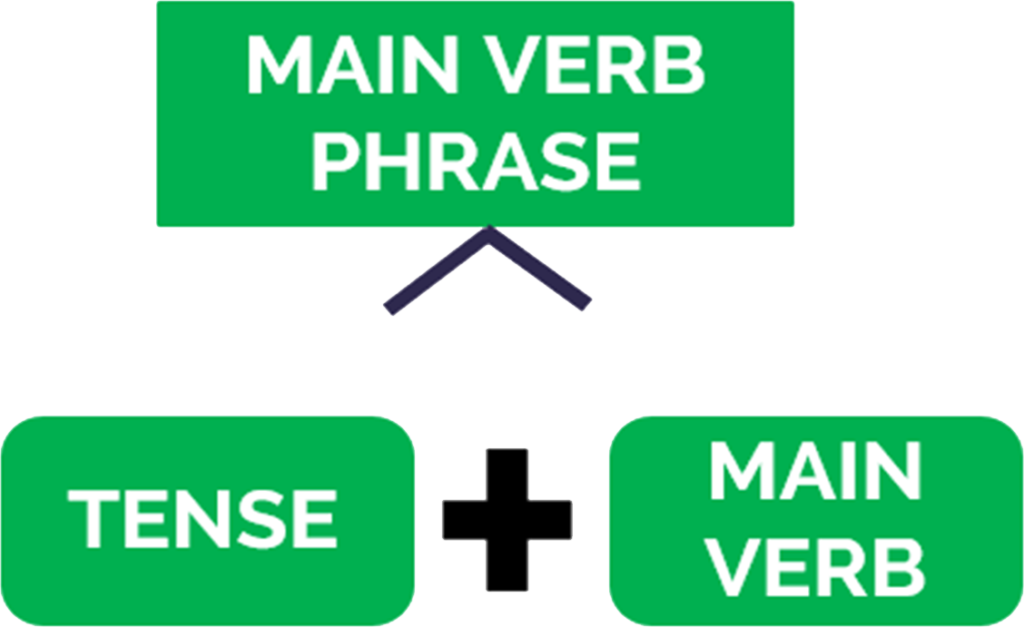Chapter 02-03: Phrases I – Main Verb Phrases
Chapter 2: main verb phrases
The predicate makes up the second required element for all clauses. The Main Verb Phrase is required for all predicates. Like the noun phrase, the main verb phrase is best understood by its required and optional elements. The main verb phrase consists of the main verb of the clause plus its auxiliary or helping verbs in an unchanging order. We can represent the main verb phrase linguistically as the Main Verb Phrase Formula:

The main verb phrase formula, also know as the verb expansion rule, is a descriptive analytical tool, designed to help you distinguish between the main verb phrase and other, especially, non-finite verb phrases. Once you identify a main verb phrase, you can understand in the context of a particular clause because it will always follow a predictable pattern. We can think of this pattern as the function slots for the main verb phrase.
The main verb phrase has two required elements and three optional elements, but, like the noun phrase, the main verb phrase can be one word or multiple words. This is because the two required elements are tense and the main verb:

In other words, TENSE and MAIN VERB will exist in every Main Verb Phrase. If both are not present, the structure is NOT a main verb phrase.
In English, TENSE is actually at the beginning of the main verb phrase, which may seem antithetical to how you have always thought about the main verb. So when analyzing, you always start with the first verb in the main verb phrase (whether that’s a single word or multiple words). In English, TENSE can only be PRESENT or PAST. (While some argue that the use of MODALS creates a FUTURE tense, for our purposes, and simplicity, we are sticking with only PRESENT or PAST.) For example:
- John yells. (present tense)
- John yelled. (past tense)
- John has yelled. (present tense – notice TENSE is on the first verb, the auxiliary)
- John could have yelled. (present tense – the modal comes first; since modals do not take tense markers, modals are ALWAYS present tense)
- John was yelling. (past tense – notice TENSE is on the first verb, the auxiliary)
- John could be yelling. (present tense – the modal comes firsst, but modals do not take tense markers, so modals are ALWAYS present tense))
- John had been yelling. (past tense – notice TENSE is on the first verb, the auxiliary)
In these seven examples, you can see that TENSE appears on the first verb in the main verb phrase, even if it’s only a single verb. Another way to think about this is that the TENSE inflectional morpheme will always be added to the first verb in the main verb phrase, whether that first verb element is an auxiliary or the main verb. NOTE: obviously, there are exceptions to the tense inflection rule and the first verb seems to maintain its base form (present tense for first-person singular, for example). The most common exception is the MODAL auxiliary, which never takes an inflection, but is ALWAYS understood as present tense. The three optional elements in the main verb phrase are known as AUXILIARIES. If an auxiliary is present, it must appear in a specific order and it will always inflect on verb that follows it in the same way. Recall the Main Verb Phrase Formula:

If the auxiliary does not precede an inflected verb, then it is NOT a main verb phrase. For example:
- John has yelled. (PRESENT + HAVE + [-ed] + yell) NOTE: Oftentimes, the PARTICIPLE form is irregular, which, in this case, adds the -ed inflection, rather than -en.
- John could have yelled. (PRESENT + MODAL + HAVE + [-ed] + yell)NOTE: There is no inflection associated with the MODAL auxiliaries, instead requiring that the verb that follows it appear in its base form.
- John was yelling. (PAST + BE + [-ing] + yell)
- John could be yelling. (PRESENT + MODAL + BE + [-ing] + yell)
- John had been yelling. (PAST + HAVE + [-en] + BE + [-ing] + yell)
- Yelling, John was stomping his feet, as well. (PAST + BE + [-ing] + STOMP NOTE: the first word, YELLING, is NOT a main verb because it is not preceded by a BE auxiliary and -ing is not tense.
NOTE: one other important thing to remember is that while modals, HAVE, and BE are all auxiliaries, as discussed in Chapter 1, they all can be main verbs, as well, which means that they are the last (or only) verb in the main verb phrase. So keep this in mind when analyzing for main verb phrases.